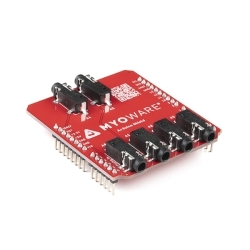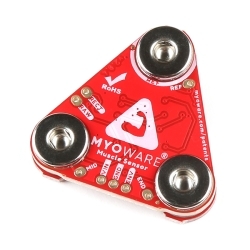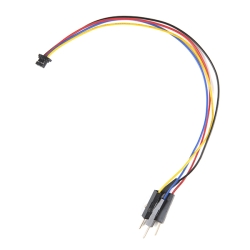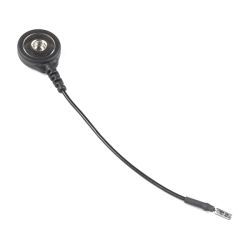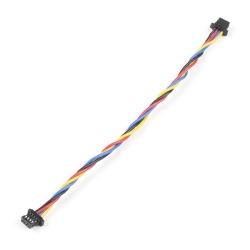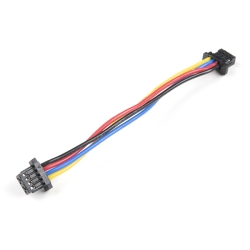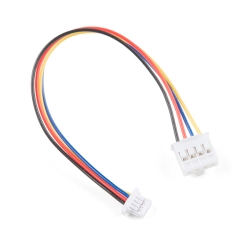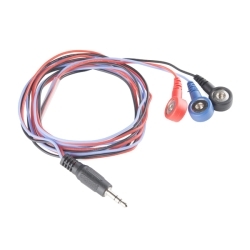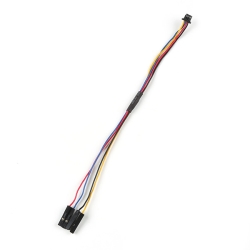MyoWare 2.0 Wireless Shield
The MyoWare® 2.0 Wireless Shield is designed to take in readings from the MyoWare 2.0 Muscle Sensor and wirelessly transmit data with the ESP32-WROOM!
Helpful Documentation
Product Overview
The MyoWare® 2.0 Wireless Shield is designed to take in readings from the MyoWare 2.0 Muscle Sensor and wirelessly transmit sensor data with the ESP32-WROOM! This shield also includes a built-in LiPo battery to remotely power the muscle sensor and the ESP32 module. The Wireless Shield is equipped with snap connectors and low-profile pogo pins on the board, so you can easily stack it on the top side of the MyoWare 2.0 Muscle Sensor. Simply select a Power Source and flip the power switch to the ON position to give the sensor all the power it needs to work its myoelectric magic.
TThe board's USB type C and CH340 USB-to-serial converter enable programming via serial using the Arduino IDE. As you might expect, a reset button resets the ESP32. Various protection circuits are built into the board: ESD protection diodes for the USB data lines, a resettable PTC fuse for VUSB, and ideal diodes for protection on the VUSB and VBATT nets.
Each board comes with a 40mAh single-cell lithium polymer (LiPo) battery connected to it. The battery can be recharged through the USB Type C connector, and its dedicated LiPo charging circuit is set to a charge rate of about 40mA. Operating your MyoWare 2.0 Muscle Sensor on battery power and transmitting data wirelessly allows for complete isolation from the power grid.
Power is regulated down to 3.3V. Users can select their power source as well as turn on/off the board with included switches. A button to manually place the ESP32 in bootloader mode is populated as well. This button can also be used as a general purpose button as well. The board is equipped with two horizontal Qwiic connectors and 2.2kΩ pull-up resistors if you decide to include additional Qwiic-enabled devices. Standard 0.1"-spaced plated through holes (PTHs) break out a few of the ESP32 module's pins on the edge of the board for users.
This board also includes status LEDs for power (PWR), charge status (CHG), user LED (13), and envelope (ENV). There are additional jumpers for power (PWR), USB shield (SHLD), reference (REF), raw EMG (RAW), envelope (ENV), and I2C pull-up resistors (I2C). Use it as a teaching tool to reduce the number of wires in your system or add some myoelectric flair to your Halloween costume!
Note: This item may take longer to process due to battery installed in the equipment and therefore does not qualify for same-day shipping policy. Additionally, these batteries can not be shipped via Ground or Economy methods to Alaska or Hawaii. Sorry for any inconvenience this may cause.
Features & Specs
- Input Voltage
- 5V via USB Type C Connector
- Output Voltage (e.g. "VIN")
- 3.3V via voltage regulator (RT9080)
- 3.3V via Qwiic Connector
- ESD Protection Diodes for USB Data Lines
- Ideal Diodes for Protection on the VBATT and VUSB Nets
- Resettable PTC Fuse (Rated 6V/500mA)
- Switches
- Power Source
- Power ON/OFF
- Built-in LiPo Battery
- Rated Capacity: 40mAh
- Nominal Voltage: 3.7V
- Max Charge Current: 1C (40mA)
- MCP73831 Single Cell LiPo Charge IC
- Charge Rate Set to ~40mA
- 3.3V Voltage Regulator
- MyoWare® 2.0 Muscle Sensor Form Factor
- 3x Female Snap Pins (Power and EMG Envelope Output)
- Espressif ESP32-WROOM Module
- CH340 USB-to-Serial Converter
- 2x Qwiic Connectors
- 2.2kΩ Pull-Up Resistors
- Button
- Reset
- General Purpose/Bootloader
- LEDs
- PWR - Power Indicator
- CHG - Charge Status
- 13 - User
- ENV- Envelope
- Jumpers
- PWR - Power LED
- SHLD - USB Shield
- REF - Reference Pin
- RAW - Raw EMG Output
- ENV - Envelope Detector Output
- I2C - I2C Pull-Up Resistors
- Board Dimensions
- 63.5mm x 38.000mm (2.50in. x 1.50in.)
- Weight: ~16.7g
Documentation
- Board Dimensions
- Hookup Guide
- Advancer Technologies: MyoWare® 2.0
- Quickstart Guide (4.37MB)
- Advanced Guide (9.00MB)
- Patents [1]
- MCP73831 Datasheet
- Polymer Lithium Ion Battery (40mAh)
- Datasheet
- MSDS
- MyoWare Arduino Library
- MyoWare 2.0 Ecosystem Page
[1] Note: This product is patent protected. To prevent counterfeit boards
Customer Reviews
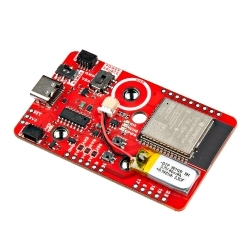
Stock and Customer Discounts
Available Discounts
- $25.60 | 10+ units
- $22.91 | 100+ units


 Hookup Guide
Hookup Guide Quickstart Guide (4.37MB PDF)
Quickstart Guide (4.37MB PDF) Datasheet (MCP73831)
Datasheet (MCP73831)

